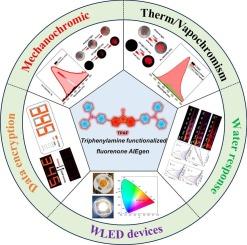Triphenylamine functionalized fluorenone derivative exhibiting aggregation-induced emission and multi-stimuli responsive property
IF 4.7
3区 化学
Q2 CHEMISTRY, PHYSICAL
Journal of Photochemistry and Photobiology A-chemistry
Pub Date : 2025-10-09
DOI:10.1016/j.jphotochem.2025.116827
引用次数: 0
Abstract
Most reported stimuli-responsive luminogens with AIE properties are single-functional. Thus, developing molecules with integrated multi-responsive capabilities presents significant research potential. In this study, a triphenylamine functionalized fluorenone derivative (TPAF) with AIE property was designed and synthesized. The material exhibited multiple properties, which included mechanochromism, thermochromism, vapochromism, anti-counterfeiting, WLED, and water sensing. TPAF exhibited weak emission in its crystalline state (C-TPAF), but displayed high-contrast “turn-on” emission upon grinding, contrary to the behavior of most mechanochromic AIEgens. Furthermore, when C-TPAF was heated, a bright amorphous luminescent form of TPAF was obtained. The fluorescence and crystalline structure of C-TPAF could be fully restored through dichloromethane fumigation. This unique stimuli-responsive behavior could be repeated multiple times with minimal change. The real-time in situ fluorescence, micrographs, powder X-ray diffraction, scanning electron microscopy, and single-crystal X-ray analysis demonstrated that the multi-stimuli response of C-TPAF could be attributed to changes in molecular packing, with TPAF transitioning between crystalline and amorphous forms under external stimuli. Owing to the unique response to various stimuli of C-TPAF, a high-performance and optical data encryption was achieved using C-TPAF, which verified through changes in luminescence induced by external heat or vapor. Moreover, TPAF exhibited strong red emission in the aggregated state. A white LED device was fabricated via doping, and it demonstrated good stability. In addition, a TPAF fluorescence-based water detector demonstrated effective detection of water in organic solvents. This study provides a theoretical basis for exploring the relationship between molecular structure and performance and offers important insights for the development of high-performance, multi-stimuli responsive materials.

三苯胺功能化芴酮衍生物具有聚集诱导发射和多刺激响应特性
大多数报道的具有AIE特性的刺激响应发光原是单一功能的。因此,开发具有综合多响应能力的分子具有重要的研究潜力。本研究设计并合成了具有AIE性质的三苯胺功能化芴酮衍生物(TPAF)。该材料具有机械变色、热变色、气相变色、防伪、WLED和水传感等多种性能。TPAF在晶态(C-TPAF)表现出弱发射,但在磨削时表现出高对比度的“开启”发射,这与大多数机械致色AIEgens的行为相反。此外,当C-TPAF加热时,获得了明亮的非晶TPAF发光形式。二氯甲烷熏蒸可以完全恢复C-TPAF的荧光和晶体结构。这种独特的刺激反应行为可以重复多次,变化很小。实时原位荧光、显微照片、粉末x射线衍射、扫描电镜和单晶x射线分析表明,C-TPAF的多刺激响应可归因于分子堆积的变化,在外界刺激下,TPAF在晶态和非晶态之间转变。由于C-TPAF对各种刺激的独特响应,利用C-TPAF实现了高性能的光学数据加密,并通过外热或蒸汽引起的发光变化进行了验证。此外,TPAF在聚合态表现出较强的红发射。通过掺杂制备了白光LED器件,并表现出良好的稳定性。此外,基于TPAF荧光的水检测器证明了对有机溶剂中的水的有效检测。该研究为探索分子结构与性能之间的关系提供了理论基础,并为高性能、多刺激响应材料的开发提供了重要见解。
本文章由计算机程序翻译,如有差异,请以英文原文为准。
求助全文
约1分钟内获得全文
求助全文
来源期刊
CiteScore
7.90
自引率
7.00%
发文量
580
审稿时长
48 days
期刊介绍:
JPPA publishes the results of fundamental studies on all aspects of chemical phenomena induced by interactions between light and molecules/matter of all kinds.
All systems capable of being described at the molecular or integrated multimolecular level are appropriate for the journal. This includes all molecular chemical species as well as biomolecular, supramolecular, polymer and other macromolecular systems, as well as solid state photochemistry. In addition, the journal publishes studies of semiconductor and other photoactive organic and inorganic materials, photocatalysis (organic, inorganic, supramolecular and superconductor).
The scope includes condensed and gas phase photochemistry, as well as synchrotron radiation chemistry. A broad range of processes and techniques in photochemistry are covered such as light induced energy, electron and proton transfer; nonlinear photochemical behavior; mechanistic investigation of photochemical reactions and identification of the products of photochemical reactions; quantum yield determinations and measurements of rate constants for primary and secondary photochemical processes; steady-state and time-resolved emission, ultrafast spectroscopic methods, single molecule spectroscopy, time resolved X-ray diffraction, luminescence microscopy, and scattering spectroscopy applied to photochemistry. Papers in emerging and applied areas such as luminescent sensors, electroluminescence, solar energy conversion, atmospheric photochemistry, environmental remediation, and related photocatalytic chemistry are also welcome.

 求助内容:
求助内容: 应助结果提醒方式:
应助结果提醒方式:


